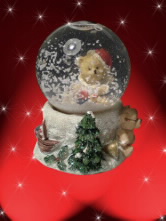FOR IMMEDIATE RELEASE | December 16, 2009
The chemistry of snow globes and other holiday gifts<br /> Check out a special new American Chemical Society video
WASHINGTON, Dec. 16, 2009 —What makes the snowflakes flutter down almost hypnotically when you shake a snow globe? People have been mesmerized by these transparent spheres enclosing a miniaturized scene since the first snow globe appeared in France almost 200 years ago.
A new video in the American Chemical Society (ACS) Chemistry of Holidays series answers that question in brilliant high-definition detail. The video, released today, showcases an actual general chemistry, or chemistry for nonscience majors, laboratory session at the Catholic University of America (CUA) devoted to the chemistry of the December/January holidays. It is available at www.BytesizeScience.com.
Media Contact:
Michael Bernstein
202-872-6042
m_bernstein@acs.org
Michael Woods
202-872-6293
m_woods@acs.org
The video features Diane Bunce, Ph.D., and her students, who perform experiments with a holiday theme. Bunce, professor of chemistry at CUA, is a recipient of the ACS Helen Free Award for Public Outreach and associate editor for Chemical Education research for ACS’ Journal of Chemical Education. The video, produced by the ACS Office of Public Affairs, shows students using the principles of chemistry to make:
- A colorful, bouncing super ball made with polymers.
- A snow globe-like stick, consisting of a test tube filled with water, glitter and glycerine. The glycerine slows the glitter and makes it look like snowflakes falling when the tube is shaken.
- A marbleized gift card made with shaving cream, paper and various food colorings.
Bunce explained that the experiments were used to demonstrate key chemistry concepts, such as polymerization cross-linking (the process in which polymer molecules link together) and viscosity and density (which keep snowflakes aflutter inside snow globes).
“We hope that students will actually hang these items on their trees at home and use them to explain the wonders of chemistry to their families and friends,” Bunce said.
A teachers’ guide with detailed instructions for each experiment is available in PDF format.
Another video in the ACS series, focusing on the Chemistry of Thanksgiving, also can be found at www.BytesizeScience.com.
###


